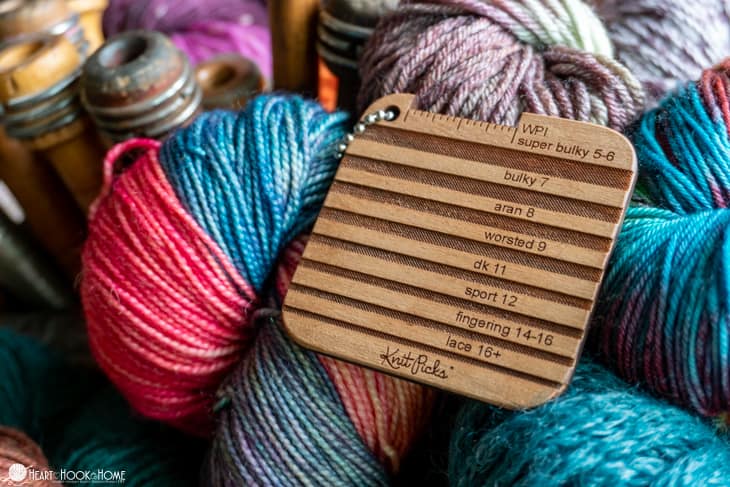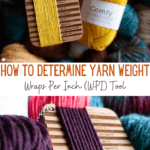How to Determine Yarn Weight Using WPI Tool
This post may contain affiliate links, meaning that I may earn a small commission if you make a purchase. See our disclosure policy for more information.
Do you have a ball of yarn that does not have the yarn weight listed on the label? Deciding which pattern to use with said yarn can be a bit nerve wracking, especially if the yarn was expensive or a gift. This Wraps Per Inch (WPI) article will help you to decide what weight of yarn you have, so that you can pair it with the perfect pattern – or similar weight yarn!

How to Determine Yarn Weight
Determining yarn weight seems like it should be an easy task. Perhaps you have some fancy yarn from a local yarn shop or a tub of yarn gifted from a friend? Of course we can all see with the naked eye that a bulky weight is not the same as a lace weight or fingering weight, but what about yarns that are very similar to one another? Enter the Wraps Per Inch tool!

With time and experience, yarn lovers will be able to tell by look or by feel (with a certain degree of accuracy) whether that yarn is a light worsted or a worsted weight. Why not know for certain, though?


What are some instances where the number of Wraps Per Inch is helpful?
1. When the yarn has no weight listed (or has no label).
2. You may, at times, want to substitute one yarn for another. Will it work? Wrap to find out! As long as the yarns have a similar number of Wraps Per Inch (WPI), they should be easily interchangeable.
3. Have you ever found the two perfect colors of yarn, but by different brands, and you’re not sure if the difference in brand/fiber content will make the blanket turn out wonky and/or thick-and-thin? This is the perfect opportunity to do a Wraps Per Inch (WPI) test!
4. Perhaps you want to double up a thinner weight yarn to make a worsted weight (or two worsted to make a bulky) and want to be sure the combination is accurate. Wrap it up! 😉
Wanna save this for later?
The WPI tool I am using here is from Knit Picks/WeCrochet.

Whatever your reasons, a WPI yarn test is quick and painless, and could stave off potential problems from the get-go. You can use an actual Wraps Per Inch tool, as I have pictured here, or you could use a knitting needle, the shaft of your crochet hook (so long as it has a consistent diameter), or a ruler etc.

To use a WPI tool, you’ll literally wrap the yarn around and around, then count how many wraps you were able to fit in 1″ width.
Before you go wrapping all your label-less yarns, try with a yarn that you already know the weight. Grab a skein of yarn from your stash, wrap it around for the width of one inch and see how accurate you are. It is important to not wrap it too tightly, but you don’t want it loose either. By testing yourself on a known yarn weight, you’ll get the feel for how taut to wrap the unknown yarn.


More on yarn, tools, & yardage:
How Much Yarn Do I Need? How to Determine Yardage in Crochet
Tapestry Needles Explained: Yarn Needles for Beginners







